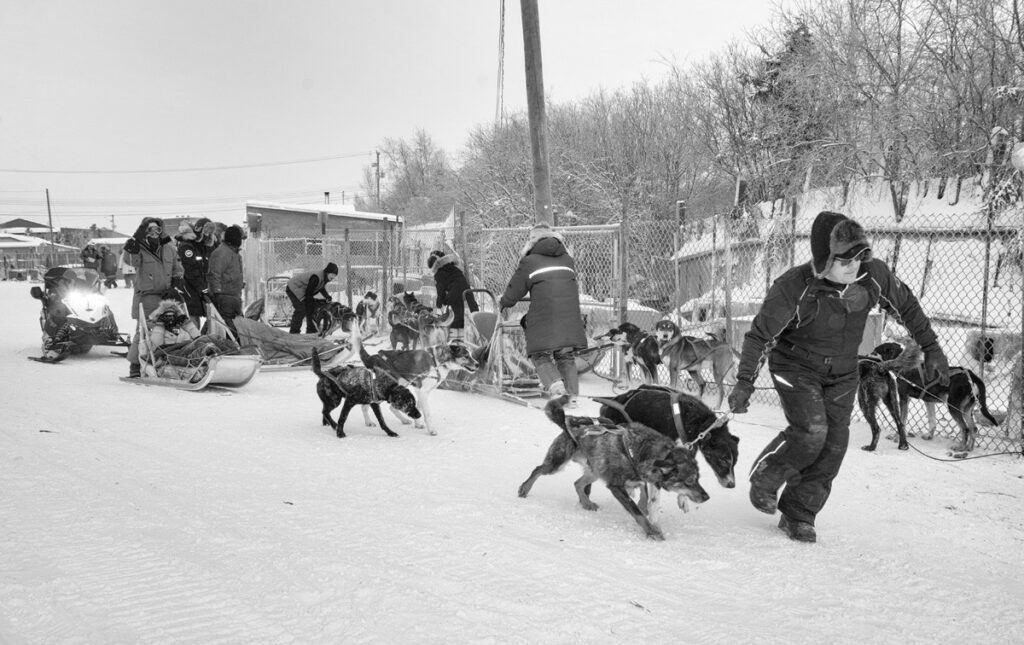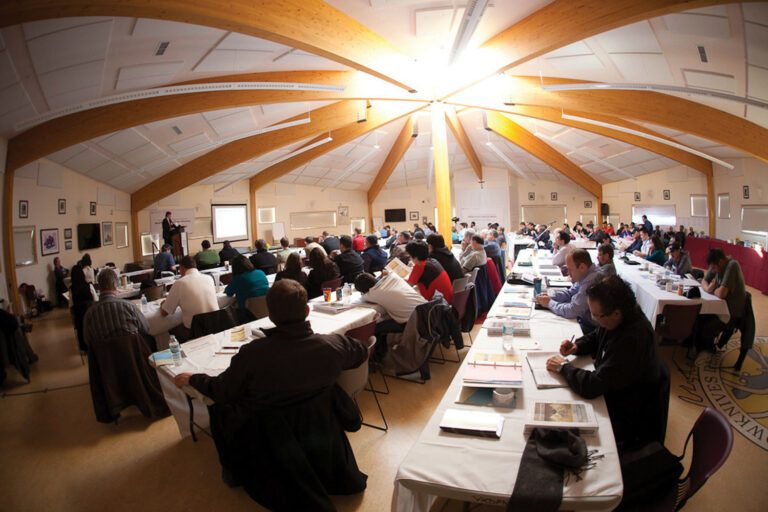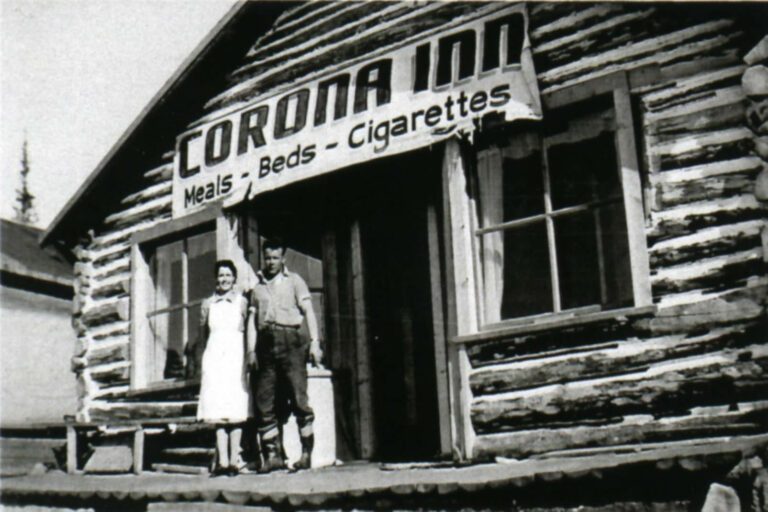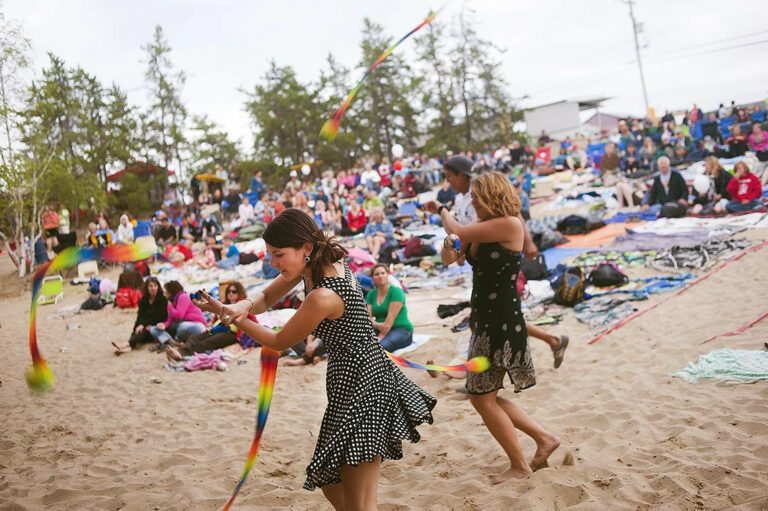When Jo Kelly arrived in Yellowknife, she came with a dog team. In 2001, almost everyone who kept sled dogs lived in Kam Lake. It was a no brainer. Kelly rented a property on Curry Drive and loved the access to wide open spaces to run her dogs. Back then, the neighborhood was the kind of place where it was just as likely to see the Debogorski’s pig roaming the roads as it was to see a team of dogs heading towards the lake or a dump truck lumbering by with a load of topsoil.
It wasn’t the kind of property most people would lust after, but it was perfect for Jo. There was a kind of ‘do your own thing’ coexistence between industry, animals and people.
“Our friends who live in the south with dogs on nice acreages and properties come here and they see all these dogs in a little industrial lot and they think its sounds horrible,” says Jo, sitting behind the desk at Qimmiq Kennels, a large dog-boarding business she started once she purchased and settled on her lot. “It does sound horrible but I tell them that we can literally cross Curry Drive and get out onto Great Slave Lake and I can go right to the Arctic Ocean and never pass a street or a power line.”
In fact, Jo joins a long list of adventurers, like American explorer Will Steger, who have set out for Arctic expeditions off Curry Drive, in Kam Lake.
On a good day, Qimmiq Kennel has between 30-50 doggy boarders. Since her house is next to the kennel, Jo and her neighbours have a soundscape that includes howling dogs, blasting, drilling and diesel engines. “We’re all tolerant and I think that’s great.”
Kam Lake, located in the city’s extreme southern limits, is an industrial park – at least that’s what it was supposed to be. It was zoned for commercial and industrial use. Yellowknife historian Ryan Silke notes that when, in 1971, the city advertised the first 10 lots at the new Kam Lake Industrial Park, Yellowknife’s core reached only to the intersection of 57th Street and Franklin Avenue. Past that was Tommy Forest Ball Park, McNiven Beach and the dump (located where William McDonald School track and field is now) and the jail (where the Multiplex is now). If Yellowknife ever had an outskirts, Kam Lake was it.
Before the 1970s, not much was happening in Kam Lake. Once, in 1936, Cominco built a prospecting camp on the east shore so that planes could land on ice-free Kam Lake, which thawed before Yellowknife Bay. When Yellowknife Bay thawed later that spring, the camp was relocated. Then in the 1940s, the Department of Transportation cut what’s now Kam Lake Road to build a radio transmission tower on the south end of the lake. That tower is still in use for airport traffic.
Families started moving into Kam Lake after lot owners were permitted to build ‘caretaker residences’ beside their businesses. Many of the founding families still live and work there. Nolting, Eggenberger, Beck, Debogorski are a few of the family names that made it so much more than just an industrial zone. It became a scrappy, somewhat eccentric community of trades people, dog mushers and heavy machine operators.
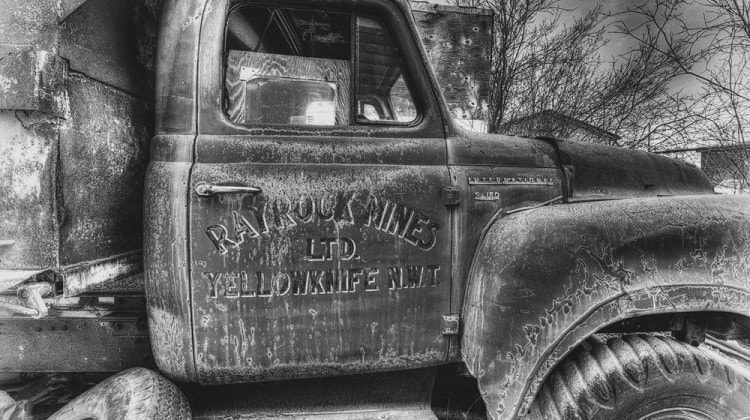





Alex Debogorski figured the city would want people like him to move out to a more industrial area after he filled up his yard on Bigelow Drive with cars. In 1981, he registered Eagle North Contracting and sat on the steps of city hall for 26 hours to get his first lot.
It would be fair to say that Alex, who has raised a family of 11 children in Kam Lake, is of Yellowknife’s old world order. He says the original residents of his neighbourhood are “stick in the mud right-wingers here to make a dollar,” and that the value of being in Kam Lake is that he can do what he wants without by-law officers slapping tickets on him. There’s space to roam and to expand.
Alex has reserved one of the lots he owns for his collection of vintage vehicles and equipment. There’s construction trucks, classic American cars and ‘50s pickup trucks. There’s an ‘80s Suburban tucked in beside what looks like an Oldsmobile. They are rough, rusty and, in a few cases, well on their way to composting. Yet, there’s a sense of entering a curated space of living monuments chronicling colourful chapters of Yellowknife industry and leisure.
“Some of this stuff that I save, people think it’s an eyesore but they don’t realize it’s the history of the city,” says Alex, pointing to a green Dodge that appears to be sinking into the ground. “That’s the first City of Yellowknife building inspector’s car – a 1952 Plymouth.”
Perhaps, he muses, there’s a market to bring tourists out here to see some of these old machines. A fire truck from Pine Point from the 1960s, a cable ripper from a 1940s cat train, a wooden boat (a ‘barrel back rum-runner’) rumoured to have been owned by Al Capone. It’s a graveyard for old vehicles and machines that were destined to be smashed at the dump.
Of course, Alex is not alone in his eye for collecting beautiful junk in Kam Lake. A cruise down Curry Drive and up around Coronation reveals mysterious and wonderful relics on display in lots and storage yards. A decommissioned truck cab here, a sleeping Volkswagen van there. Trailers, RVs, buses, boats piles outside a wooden shack puffing smoke, presumably housing a ‘caretaker.’

Debogorski
As with any old world order, new order has come calling; some of it in the form of the extension road to the airport and a new residential subdivision being built at Grace Lake, And then – there’s Homes North blasting rock next to the Yellowknife Correctional Centre for a mixed-use facility.
“Hell, in 15 years, this will all be residential and there will be none of us here,” grumbles Alex.
Jo Kelly says the biggest change she’s seen is the huge influx of traffic from new businesses and housing, which hasn’t been great for her dogs.
That said, there’s been an increasing interest in Kam Lake by people who want to experiment. Arctic Farmer’s foray into northern farming has brought chickens, donkeys and sheep into the mix. Musicians and actors have discovered buildings like the old YK Dairy make for great rehearsal spaces. Bands can rock out without worrying about noise complaints. Dermot O’Neil, who teaches drum lessons there, says, “You can’t get spaces downtown or in the malls for what we’re doing. It’s out of the way, I can make all the noise I want and nobody bothers us.”
It’s been said that Kam Lake is a bigger, bolder version of what ‘Old Town’ Yellowknife once was. Take a drive out and see for yourself. Once you hit the bump on Kam Lake Road, right around Ron’s Auto Service & Equipment, you’re crossing the border into a wilder, rougher place. Yellowknife’s industrial zone carries something of the heart of what our city once was –the grit, steel and rusted junk, along with tenacious, creative and hard-working characters – that form the backbone of the town.
For more real estate stories, the city’s best rental board and property listings, visit Property North

